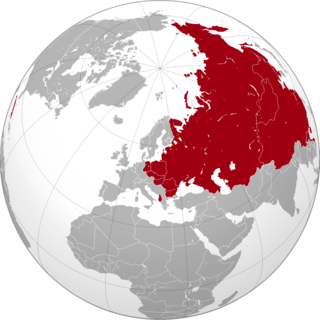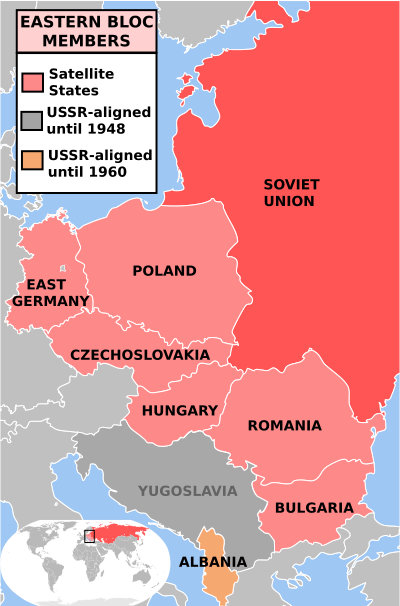Soviet imperialism

The informal term "Soviet Empire" is used by critics of the Soviet Union to refer to that country's perceived imperialist foreign policy during the Cold War. The nations said to be part of the "Soviet Empire" were independent countries with separate governments that set their own policies, but those policies had to remain within certain limits decided by the Soviet Union. Failure to stay within the limits could result in military intervention by the Warsaw Pact. Countries in this situation are often called satellite states. This arrangement was always unofficial.
Though the Soviet Union was not ruled by an emperor and declared itself anti-imperialist, critics[1][2] argue that it exhibited tendencies common to historic empires. Some scholars hold that the Soviet Union was a hybrid entity containing elements common to both multinational empires and nation states.[1] It has also been argued that the USSR practiced colonialism as did other imperial powers.[3]
The other dimension of "Soviet imperialism" is cultural imperialism. The policy of Soviet cultural imperialism implied the Sovietization of culture and education at the expense of local traditions.[4]
Influence
The Soviet Empire is considered to have included the following:[5][6]
 The Soviet Union and its satellite states
The Soviet Union and its satellite states

These countries were the closest allies of the Soviet Union. They were members of the Comecon, a Soviet-led economic community founded in 1949. In addition, the ones located in Eastern Europe were also members of the Warsaw Pact. They were sometimes called the Eastern bloc in English and were widely viewed as Soviet satellite states.
.svg.png) Bulgaria
Bulgaria Cuba
Cuba Czechoslovakia
Czechoslovakia East Germany
East Germany Hungary
Hungary.svg.png) Mongolia
Mongolia Poland
Poland.svg.png) Romania
Romania North Vietnam/Vietnam (1950-1976/1976-1991)
North Vietnam/Vietnam (1950-1976/1976-1991).svg.png) Albania (ended participation in Comecon after 1961 due to Sino-Soviet Split)
Albania (ended participation in Comecon after 1961 due to Sino-Soviet Split)
![]() North Korea was a Soviet ally,[7] but always followed a highly isolationist foreign policy and therefore it did not join the Comecon or any other international organization of communist states.
North Korea was a Soviet ally,[7] but always followed a highly isolationist foreign policy and therefore it did not join the Comecon or any other international organization of communist states.
Soviet involvement in the Third World
Some countries in the Third World had pro-Soviet governments during the Cold War. In the political terminology of the Soviet Union, these were "countries moving along the socialist road of development", as opposed to the more advanced "countries of developed socialism", which were mostly located in Eastern Europe, but also included Vietnam and Cuba. Most received some aid, either military or economic, from the Soviet Union, and were influenced by it to varying degrees. Sometimes, their support for the Soviet Union eventually stopped, for various reasons; in some cases the pro-Soviet government lost power, in other cases the pro-Soviet forces were overthrown by military coups promoted by the United States (such as in Chile and Brazil[citation needed]), in some cases the pro-Soviet forces gained power by military aid from the Soviet Union (such as in Vietnam), while in other cases the same government remained in power but ended its alliance with the Soviet Union.

Some of these countries were not communist states. They are marked in italic.
-
 Egypt (1954–1973)
Egypt (1954–1973) -
 Syria (1955–1991)
Syria (1955–1991) -
.svg.png) Iraq (1958–1961)
Iraq (1958–1961) -
 Guinea (1960–1978)
Guinea (1960–1978) -
 Somalia (1961–1977)
Somalia (1961–1977) -
.svg.png) Ghana (1964–1966)
Ghana (1964–1966) -
 Peru (1968–1975)
Peru (1968–1975) -
 Sudan (1968–1972)
Sudan (1968–1972) -
.svg.png) Libya (1969–1991)
Libya (1969–1991) -
 People's Republic of the Congo (1969–1991)
People's Republic of the Congo (1969–1991) -
 Chile (1970–1973)
Chile (1970–1973) -
 People's Democratic Republic of Yemen (1969–1990)
People's Democratic Republic of Yemen (1969–1990) -
 Uganda (1966–1971)
Uganda (1966–1971) -
 Madagascar (1972-1991)
Madagascar (1972-1991) -
.svg.png) People's Democratic Republic of Ethiopia (1974–1991)
People's Democratic Republic of Ethiopia (1974–1991) -
 Lao People's Democratic Republic (1975–1991)
Lao People's Democratic Republic (1975–1991) -
.svg.png) Benin People's Republic of Benin (1975–1979)
Benin People's Republic of Benin (1975–1979) -
.svg.png) People's Republic of Mozambique (1975–1990)
People's Republic of Mozambique (1975–1990) -
 People's Republic of Angola (1977–1991)
People's Republic of Angola (1977–1991) -
.svg.png) Democratic Republic of Afghanistan (1978–1991)
Democratic Republic of Afghanistan (1978–1991) -
 Grenada (1979-1983)
Grenada (1979-1983) -
 Nicaragua (1979–1990)
Nicaragua (1979–1990) -
 People's Republic of Kampuchea (1979–1989)
People's Republic of Kampuchea (1979–1989)
Communist states opposed to the Soviet Union

Some communist states were openly opposed to the Soviet Union and many of its policies. Though their forms of government may have been similar, they were completely sovereign from the USSR and held only formal ties. Relations were often tense, sometimes even to the point of armed conflict.
 Yugoslavia (Informbiro 1948)
Yugoslavia (Informbiro 1948).svg.png) Albania (following the Sino-Soviet split)
Albania (following the Sino-Soviet split) China (following the Sino-Soviet split)
China (following the Sino-Soviet split) Democratic Kampuchea (1975–1979, due to Sino-Soviet split and Cambodian-Vietnamese War)
Democratic Kampuchea (1975–1979, due to Sino-Soviet split and Cambodian-Vietnamese War) Somali Democratic Republic (1977–1991, due to the Ogaden War)
Somali Democratic Republic (1977–1991, due to the Ogaden War)
See also
- Index of Soviet Union-related articles
- American imperialism
- Cominform
- Greater Germanic Reich
- Imperialism
- Evil Empire
- Communist state
- Sino-Soviet split
References
- ↑ 1.0 1.1 Beissinger, Mark R. 2006 "Soviet Empire as 'Family Resemblance,'" Slavic Review, 65 (2) 294-303; Dave, Bhavna. 2007 Kazakhstan: Ethnicity, language and power. Abingdon, New York: Routledge.
- ↑ http://www.jstor.org/pss/20031013 Foreign Affairs, Vol. 32, No. 1, Oct., 1953 - Soviet Colonialism In Central Asia by Sir Olaf Caroe
- ↑ Caroe, O. (1953). "Soviet Colonialism in Central Asia". Foreign Affairs 32 (1): 135–144. JSTOR 20031013.
- ↑ Natalia Tsvetkova. Failure of American and Soviet Cultural Imperialism in German Universities, 1945-1990. Boston, Leiden: Brill, 2013
- ↑ Cornis-Pope, Marcel (2004). History of the Literary Cultures of East-Central Europe: Junctures and disjunctures in the 19th and 20th centuries. John Benjamins. p. 29. ISBN 978-90-272-3452-0.
- ↑ Dawson, Andrew H. (1986). Planning in Eastern Europe. Routledge. p. 295. ISBN 978-0-7099-0863-0.
- ↑ Shin, Gi-Wook (2006). Ethnic nationalism in Korea: genealogy, politics, and legacy. Stanford University Press. p. 94. ISBN 978-0-8047-5408-8.